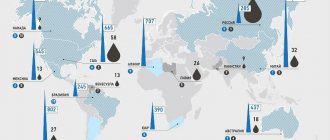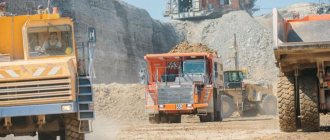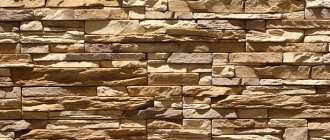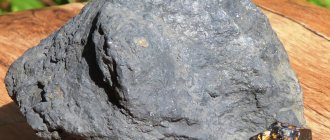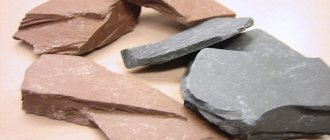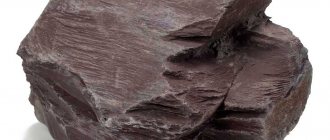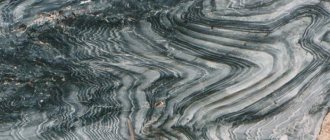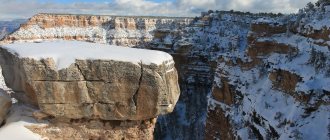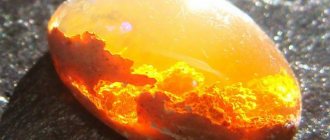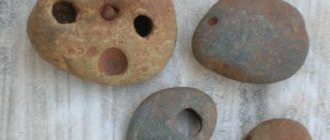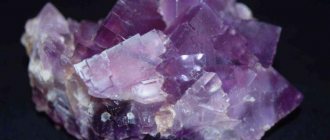There are many fossil rocks, most of us do not know even half of them that exist on Earth. Only geologists and representatives of a number of other professions can boast of complete knowledge in this area. But it happens that for the sake of interest, or for some reason we need to learn about this or that breed, that’s why articles like this exist.
Today we will talk about shale. Let's find out what they are, how they are formed, where they are found, what types they are and much more about them.
- Crystal shales
- Talc slates
- Chlorite shales
- Shales
- Prevalence
- Applications of shale
Where is oil shale mined in Russia?
On the territory of our country, large deposits of shale have been explored in two regions - in the Urals and the Caucasus. The shales of the Ural deposits have a fine-grained structure with completely lost primary textures and structures.
Interesting materials:
How do I send messages on behalf of a group? How to reply to comments as a Facebook page? How to respond to comments on VK on behalf of a group? How to reply to a comment as a Facebook page? How to rename a contact's name in Viber? How to rename a name in ZOOM? How to transfer the name Inna? How is the name Inna transferred? How is the name Zhanna translated? How is the name Aida translated from Arabic?
General concept
The name slate hides a whole range of rocks with very diverse properties and appearance. What these rocks have in common is the presence of layered (parallel) intergrowths of medium- or low-temperature minerals. Eg:
- actinolite;
- quartz;
-muscovite;
- chlorite;
- epidote, etc.
Often, shale rocks can preserve all sorts of relict structures in good condition, which are sort of preserved between layers. This is primarily characteristic of the Solenhofen shales, which were presumably formed in ancient sea lagoons. All shales belong to the so-called metamorphic rocks.
Their characteristic feature is the ability to split into tiles or thin plates. This ability is called foliation. Shales are divided according to several parameters, one of them is the method of formation. They are divided into:
- Orthoshales - formed during the metamorphism of igneous rocks;
- Paraschists are formed as a result of the transformation of sedimentary rocks.
They are also divided according to the degree of metamorphism:
- weakly metamorphosed;
- intermediate metamorphosed;
- deeply metamorphosed.
Interestingly, the formation of these minerals depends on several factors in addition to chemical composition. The main one is the depth at which the formation process took place. In other words, an important factor is thermodynamic conditions. So if such conditions are strong, these rocks become crystalline schists.
Next we will look at several types of slates in more detail.
History of the stone
The word slate is formed not from the verb to send, as can rightly be noted, but from lay, lay. In the old days, this is what they called schist... Schists are a metamorphic (altered) rock formed during the Ordovician period 500 million years ago, formed from dark-colored minerals, feldspar or quartz. The concept of metamorphism is the change under pressure and temperature of an existing rock in the depths of the earth's crust in an environment of gases and aqueous solutions due to volcanic and tectonic processes. Increasing temperature accelerates chemical reactions, promotes recrystallization, increases porosity and thus permeability to various minerals and fluids. The result is a rock that shimmers in the sun.
Chlorite shales
The chlorite schists just mentioned above are no less interesting than the species described above. They are mostly formed from chlorite flakes, as well as a certain amount of quartz, magnetite, epidote, actinolite, and sometimes albite. It belongs to rather soft flake-shale rocks.
Thanks to chlorite, which is the basis of these slates, they have a special green color. Moreover, the plates of such slate usually have a very beautiful and bright shine if light hits them
This shale is formed during metamorphism, low intensity, with low temperature and pressure. At the same time, an important point in their formation is the presence of water, which acts as an element in the formation of chlorite, which is released from the original minerals. For example, such as amphiboles or biotite, as well as a number of others.
Shales
Another common type of slate. The main part is solid rock, the composition of which is similar to clay. In general, it is visually similar to clay. But unlike it, it differs in fine-grained layers. Moreover, such shale often includes a wide variety of inclusions, from all kinds of minerals to oil.
Its color range varies greatly. It starts from black and dark gray tones and ends with green and red colors. Hydromicas, chlorides and other substances can constitute a very significant process in it. Traditionally, the layers of such shale are strictly parallel to each other. It also differs from clay in that it does not get wet in water.
This type of shale is formed due to the gradual compaction and even incomplete recrystallization of clays.
Talc slates
Another type of slate that has an unusual property. As mentioned above, all slates can split into thin and rather thin tiles. But talc slates have the ability to be divided into very thin layers.
The fact is that the main components of this type of rock are mica and talc. They belong to layered silicates. A characteristic feature of which is easy splitting into the thinnest possible plates.
Since these shales are a product of metamorphic processes, their individual layers of talc and mica flakes are parallel to each other. Due to its low hardness and layered structure, this slate can be cut even with an ordinary sharp knife.
Speaking about the composition, it should be noted the following substances that are found in this shale in addition to talc (its main component):
- antigoria;
- Cummingtonite;
- tremolite;
- chlorite;
- megnetin (most often).
Feldspars, micas and quartz may also be found in it. By the way, the ratio of certain mineral components affects the colors and shades of the rock.
These shales are very similar in structure to their fellow tremolite and chlorite shales. It is clear from the names that the main components of such shales are tremolite or chlorite, respectively.
It should be noted that talc shales should not be confused with talc, which is a distinct fossil mineral. Unlike talc slate, it does not contain grains of other rocks and is distinguished by other formation features. In addition, talc is much rarer than its slate relative.
How are Greisens formed?
Greisens are formed
at a temperature of 400-500 degrees Celsius, and are associated with changes in granite rocks under the influence of gases and solutions separated from cooling granite bodies.
Interesting materials:
What should you not do before laser resurfacing? What should you not do before going to the endocrinologist? What should you not do before visiting a manicurist? What should not be done before a puncture? What should not be done before lip augmentation? What should you not do after self-tanning? What should you not do after a gastric biopsy? What should you not do after a biopsy? What should not be done after Bioreparation? What should you not do after hair Botox?
Crystal shales
This type of slate has a number of distinctive features, the first and most obvious of which is, of course, its structure, which is clear from the name itself. The second, determined visually by the presence of a pronounced banded texture.
In terms of composition, traditionally this type of shale contains a predominant amount of quartz, biotite and muscovite. The last two are familiar to most of us under the term mica. Some of them also include amphiboles, scapolite, pyroxenes or plagioclase. There are also cases when the composition of such shale also includes dark-colored minerals.
In addition, it should be noted that this type of shales often contains specific rocks of metamorphic minerals, such as:
- almandine, familiar to us under the name garnet;
- andalusite;
- staurolite and kyanite;
- sillimanite and scapolite.
In rare cases, carbonates and other substances are found. If we consider the mineral composition, crystalline schists are divided into:
- andalusite-biotite schists;
- diopside-scapolite, plagioclase or carbonate shales;
- quartz-bearing mica schists;
- garnet-biotite schists, etc.
Physico-chemical characteristics and varieties
More than 3 thousand mineral agglomerates are known in the world. For description and classification, a diagnostic technique based on physical, mechanical and chemical properties is used. This is necessary for an unambiguous identification of a particular mineral resource. Physical characteristics mean:
- optical:
- color;
— transparency;
- shine;
- mechanical:
— hardness;
- cleavage;
- special (the ability to deflect a magnetic needle, a characteristic garlic smell after rubbing, plasticity and others).
To further understand the concept of rock hardness, it is useful to become familiar with the Mohs scale, named after the 18th-19th century German mineralogist and geologist.
| Name of mineral | Appearance | Hardness | Machinability |
| Talc | 1 | Nail scratches remain | |
| Gypsum | 2 | Nail scratches remain | |
| Calcite | 3 | Traces of a copper coin remain | |
| Fluorite | 4 | Scratched by a steel nail or glass shard | |
| Apatite | 5 | Scratched by a steel nail or a piece of glass, but only with force | |
| Orthoclase | 6 | Mineral scratches glass, can be processed with a file | |
| Quartz | 7 | Processed with diamond, leaves scratches on glass | |
| Topaz | 8 | Processed with diamond, leaves scratches on glass | |
| Corundum | 9 | Processed with diamond, leaves scratches on glass | |
| Diamond | 10 | Cuts glass |
Let's consider the properties of slates, which have become widespread in industrial sectors, construction and decorative crafts.
- Clayey is a hard rock with a cryptocrystalline structure from gray to reddish in color with a matte sheen. It has a variety of shades and color saturation. Consists mainly of clay minerals, hardness 2-4 (slips on glass without leaving scratches). In rare cases, the presence of quartz may leave scratches. The presence of carbonate inclusions (calcite, marl, dolomite) is indicated by a chemical reaction with hydrochloric acid. The strength characteristics are significantly influenced by schistosity and cracks. The strength is low, it breaks easily along the schistose plane, varies from 20 MPa for talc and chlorite schists to 100-200 MPa for mica schists, however, for clayey schists the figure is less than 20 MPa. Almost all samples are anhydrous. According to the composition of minerals, they are divided into: – calcareous – contains calcite (5-22%), enters into a chemical reaction when exposed to hydrochloric acid; – siliceous-clayey – contains silica, is quite strong and hard; – roofing – capable of stratification into small-thick solid plates; – graphite – grayish, due to graphite crystals it leaves a line on the surface of the paper, dirtying your hands, tactilely greasy and soft; – bituminous – due to the presence of bitumen in the composition – black. When heated, a specific smell appears; – carbonaceous – black in color, draws on paper, but weakly. Hardness is low.
- Mica slate. It mainly contains various micas, hence the name. The color varies and is due to the micas contained in the rock. Includes sericite (thin scales), biotite, muscovite (light color). Forms a silky pearlescent sheen, sometimes silvery with a coarse-scale structure. The main difference from other types is the greater presence of mica relative to quartz. According to the composition of minerals it is divided into: – biotite (black shale); – muscovite (light); – double mica (same muscovite-biotite ratio); – mica-chlorite (difference from other varieties – the presence of chlorite, has a greenish color). – sericite is represented by sericite flakes, light gray in color with greenish inclusions. Clay mineralization is minimal. Hardness 3 (scratches plaster).
- The slate is nodular. Sometimes called mottled due to its texture and presence of mineral inclusions (spots). Color with a wide range, from dark gray to brown. Cryptocrystalline structure with mineral inclusions in the node zone. Pronounced mottled texture. Clay minerals interspersed in hematite and magnetite nodes are rock-forming. Stone samples react to a magnetic needle.
- Talc slate. It got its name because of its slate-like structure and the predominant presence of talc. A white, sometimes yellowish rock with a fine-grained structure, consisting of talc (greasy, leaves fingernail marks), quartz (scratches glass), and inclusions of calcite and chlorite (greenish color). Distinctive feature – soft, hardness on the scale – 2.
- Chlorite shale. It owes its name due to its schistosity and chlorite content. There is a beautiful green slate shimmering in the sun. With a cryptocrystalline structure, crystals of ore inclusions are often visible. Contains talc and chlorite and has a slightly greasy feel. Hardness value - 2.5. If there is more talc, then the shale is chlorite-talc, if there is mica, then it is chlorite-mica.
There are also oil shale, but we’ll talk about them a little later.
Prevalence
Most types of slate are common throughout the world. But still not everything. So one of the most common is clay shale, which can be found in most countries of the world.
But chlorite shales are not very common, it is known for sure that their deposits exist:
- in the Ural Mountains and a number of other regions of Russia;
- in the state of Tyrol (Austria);
- in Australia;
- in several regions of England;
- Turkey;
- in South Africa and on the island of Madagascar;
- on the territory of China;
- in the United States of America.
Talc shales are widespread in the mountains and foothills of the Urals, in southern Siberia and other regions of Russia. In Ukraine, European countries (especially in the Alps), Brazil, the United States, etc.
Crystalline ones are also very widespread, they can be found in all areas designated as metamorphic. In particular, on the Ukrainian and Baltic shields and folded areas, for example, in the Alps. They can also be found on continental margins, for example on Sakhalin Island. This is just a small part of a long list that includes South Africa, Japan and America, etc.
By the way, an interesting fact: most of the famous Manhattan Island, which is part of the city of New York, consists of crystalline slate.
Magic properties
Since ancient times, people have endowed minerals with the power of magic. There is a belief that our wonderful stone also provides a subtle connection between man and the cosmos. Of course, this is not so easy to do the first time and right away, so there is a certain ritual. At midnight, when the Moon is full, light 2 candles, place a shale shard between them and gaze at it for half an hour. He himself will show all his strength. After some time, pictures and images of figures will appear. Ask him to interpret these visions, and he will do it. Only for this you need to put it under the pillow, after wrapping it in a silk scarf. The interpretation of what you see will happen in a dream.
